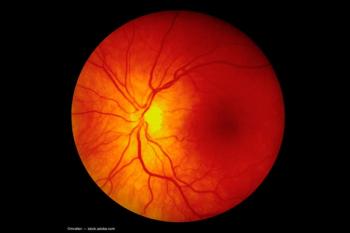
Q&A: Inside the CCOI Myopia Workshop with Assoc Prof Daniel Ting

As myopia becomes a worldwide epidemic, the upcoming Paris workshop on September 8, 2025, will convene global leaders to discuss strategies, research priorities, and new treatment pathways.
As myopia rates continue to climb globally—emerging as a major concern not only in Asia but increasingly in the West—the upcoming Collaborative Community on Ophthalmic Innovation (CCOI) Myopia Workshop in Paris, France, on September 8, 2025, will spotlight urgent questions in research, treatment, and public health. The meeting marks the first time CCOI has taken its workshop outside the United States, reflecting the worldwide need for collaboration in tackling this epidemic.
To preview the discussions, The Eye Care Network spoke with Assoc Prof Daniel Ting, program co-chair of the myopia workshop, to learn more. Ting is a senior consultant vitreoretinal surgeon with the Singapore National Eye Centre (SNEC) and concurrently, associate professor, SingHealth Duke-NUS Ophthalmology and Visual Sciences Academic Clinical Programme (ACP) and adjunct clinical associate professor and an innovation mentor at Stanford University. He is also the director of Singapore Health Service (SingHealth) AI Office, SNEC Chief Data and Digital Officer, and head of AI and Digital Innovation in Singapore Eye Research Institute (SERI).
To register or learn more about the CCOI Myopia Workshop, click
Note: This transcript has been edited lightly for clarity and length.
What makes the upcoming CCOI Myopia Workshop in Paris so important?
Assoc Prof Daniel Ting: We are excited to have the first CCOI Myopia Workshop outside the United States, in the romantic city of Paris on September 8—given the importance of myopia becoming a global epidemic not just in the East but in the West as well.
What we’ve seen in the myopia space is that the care is fairly fragmented. Different countries will have different strategies in managing myopia. There are many myopia products that have been introduced to the market over the past 5 to 10 years, some of which are currently in clinical trials. Those are the important topics that we going to talk about. How we look at the treatment landscape, from the optical options, contact lens options, eye drops, or the more novel light therapy. How you design the clinical trials with the end point that is acceptable by the regulators, for example, and whether one regulator says it’s okay in the US, does it mean that it’s okay in China or in Asia or in the Europe.
Also, one of key point that we are going to focus on during the workshop is the safety considerations. How do you take all this into account when you design lenses? How long do you have to run your study? Is the study duration 1 year? 2 years? After the 2 years, do we continue to perform the surveillance, because we know these children are prone to rebound, meaning that when you take them off treatment the myopia may escalate at a rapid pace.
Super excited to get a lot of experts into 1 room. We hope to publish some of the findings after the workshop so stay tuned.
From your perspective, what are the most urgent research priorities in slowing myopia progression globally?
Ting: The key priority for research is in terms of the clinical trials, the design and definition of the end points. What do we mean by an effective treatment and for what period, and how much are you going to slow down the progression? In terms of the safety, it’s no different from how we evaluate any new drugs or new medical device. Same for myopia.
We’re not going to have 100% of the answers after the workshop, but even if we get to 25% to even 50% that’s already a big win.
Singapore has been at the forefront of school-based and public health initiatives for myopia. What lessons can other countries learn from these efforts?
Ting: At the Singapore Eye Research Institute (SERI), we started myopia research more than 20 years ago. Kudos to all my predecessors in recognizing the importance of the topic. Unfortunately, it’s been known as the myopia capital of the world. One thing is because we do screen, and we do collate and collect the data early on. And the approach that we take is to look at the different ministries in Singapore, the primary schools and universities, and the National Eye Center and SERI. Those are the few key stakeholders that have started the initiative to first look at the population-based prevalence rate for myopia. That’s the No. 1 thing that we look at.
Prevention is always better than cure, as we all know, and in myopia the simple intervention is to go off the [computer] screen and to spend time outdoors. In Singapore, we are taking a start early and go upstream approach, meaning that we are starting to screen the children as early as 5 years old when they are in kindergarten.
Once you have a diagnosis of myopia, what’s next? Usually, and hopefully, we first prescribe glasses to prevent amblyopia. Sometimes one eye is much more severe than the other, so you have anisometropic type lazy eye. Those are the things that we hope to catch early to prevent the long-term visual implication for children.
We also have started looking into drug development, including atropine eye drops. We were one of the first in the world to look into this space with a concentration as high as 1% back then. Now, the concentration has been significantly diluted to 0.01%. That is an effective way to slow the myopia, hopefully without impairing the near vision. But again, some studies the last 2 to 3 years have shown a mix of results coming from atropine. Has the study design been done properly? Has the population that is being studied the appropriate group for this specific concentration of atropine, and when youmake the atropine in US versus when you make the atropine in Asia, is it the same? Is it different? Those are the urgent research priorities area, because the populations between Asia, the Western world, and Africa will behave differently. How you design the clinical trials and with the specific end point targeting the specific population is highly important.
In light of CCOI’s collaborative mission, how can interdisciplinary partnerships—bringing together clinicians, AI scientists, and policymakers—drive meaningful progress in global myopia management?
Ting: One key thing that we are trying to do is to bring people together in the same setting. As I mentioned before, myopia care touches a lot of highly important stakeholders: the governments, the schools, the schoolteachers, the optometrists, and the ophthalmologists and the myopia specialists. When you have high myopia, you are more prone to have myopic-related glaucoma, the retina complications, or retina tear detachments. When you look at myopia care, it touches the different subdisciplines in ophthalmology and also in the upstream as well.
Who is going to be paying is also another big question. When the Ministry of Finance sets aside the health budget, do they give this budget to the Ministry of Education or should they give this budget to the Ministry of Health? Those are the big questions that we also need to address. We hope through the CCOI workshop that we could start a think tank with people to bring their expertise.
Also, we want to engage the industry more. By having strong industry leaders in the room, we also would understand some of the challenges that they are facing. For all the novel drugs, AI medical devices, spectacle lenses, or contact lenses, you need the industry to push it forward. You need them to bring the products to the commercial space. We hope, through this workshop, we can help the patients as well in terms of having better access to all these myopia care products. The cost is something that we have to focus on as well, since we are talking about the quality of care and the equity of care.
Before we wrap up, is there anything we haven’t touched on that you feel is essential for our audience to know?
Ting: We will be organizing more future events, not just in Europe. We are planning one in Asia next year. And, of course, the CCOI meetings at the major US ophthalmology meetings, we’ll be doing that as well. Anyone who’s interested in this myopia space, we would be happy to include you.
Newsletter
Don’t miss out—get Ophthalmology Times updates on the latest clinical advancements and expert interviews, straight to your inbox.













































